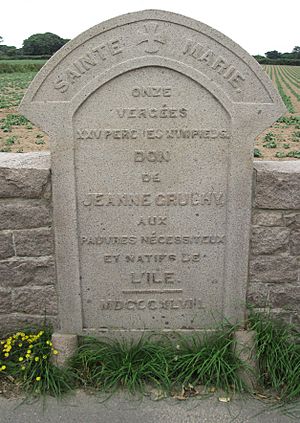Vergée facts for kids
A vergée is an old way to measure land area. It's like a special unit of space, similar to how we use square meters or acres today. You might also see it spelled as vergee, vergie, or vrégie. It is not part of the modern SI system, which uses units like the square metre.
The word "vergée" comes from the Latin word virga, which means "rod." It's also related to the French word verge, meaning "yard."
Contents
Where is the Vergée Used?
The vergée is a traditional way to measure land in the Channel Islands. These islands are located between England and France. However, the exact size of a vergée is a little different depending on which island you are on.
In Guernsey
In Guernsey, one vergée is equal to 17,640 square feet. This is about 1,639 square meters. It is made up of 40 smaller units called Guernsey perches. Each Guernsey perch is a square that measures 21 feet by 21 feet.
In Jersey
In Jersey, one vergée is a bit larger. It measures 19,360 square feet, which is about 1,798.6 square meters. Like in Guernsey, it is also made up of 40 Jersey perches. A Jersey perch is a square that measures 22 imperial feet on each side.
In Old France
Long ago, the vergée was also used in France. In France, one vergée was 12,100 square Paris feet, which is about 1,276.8 square meters. It was made up of 25 square perches. The size of a perch could vary, but a common surveying perch was 22 French feet.
Converting Vergées to Other Units
Since the vergée is an older unit, it's helpful to know how it compares to more common measurements like square meters and acres.
Guernsey Vergée Conversions
One vergée in Guernsey is equal to:
- 1,638.81 square meters (m²)
- About 0.405 acres
Jersey Vergée Conversions
One vergée in Jersey is equal to:
- 1,798.60 square meters (m²)
- About 0.444 acres



